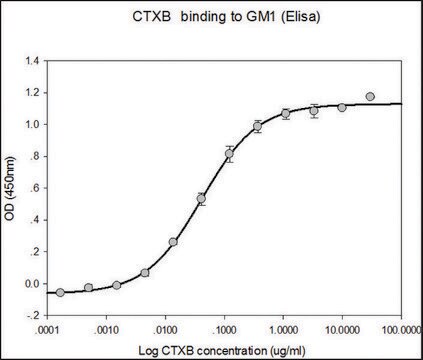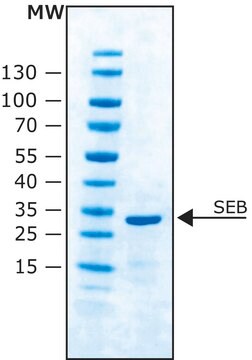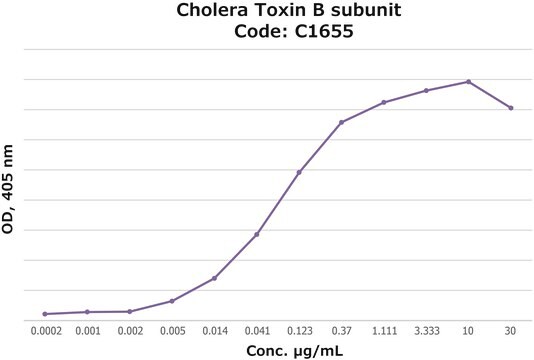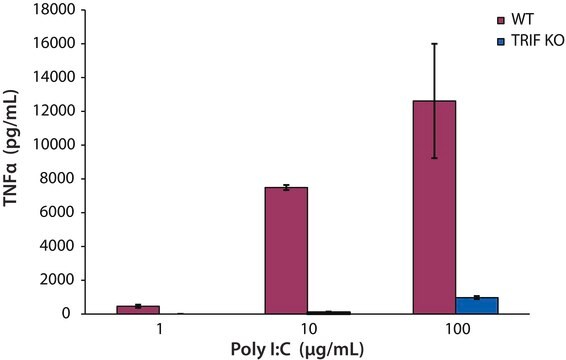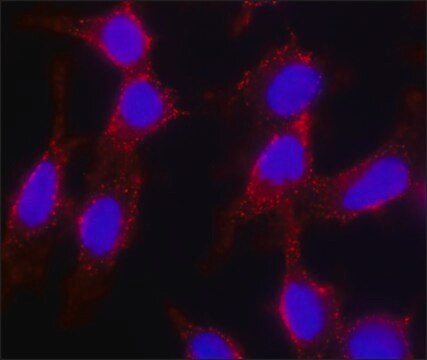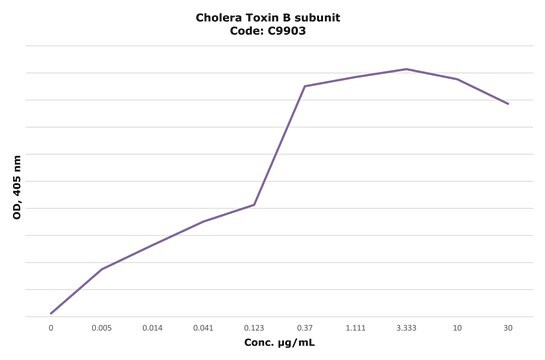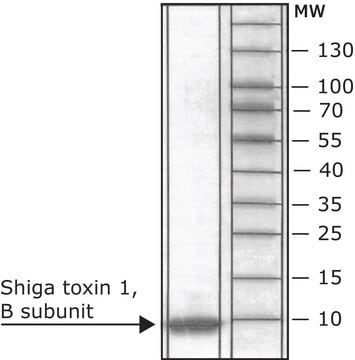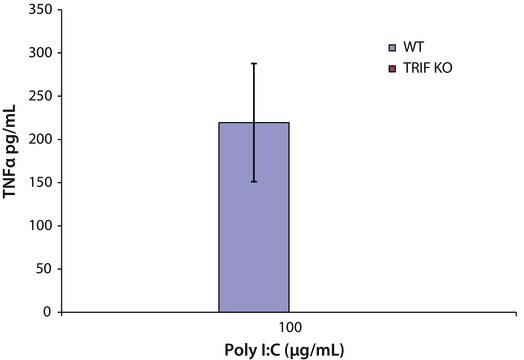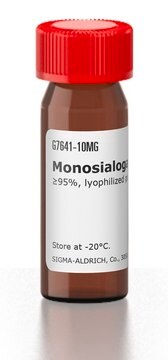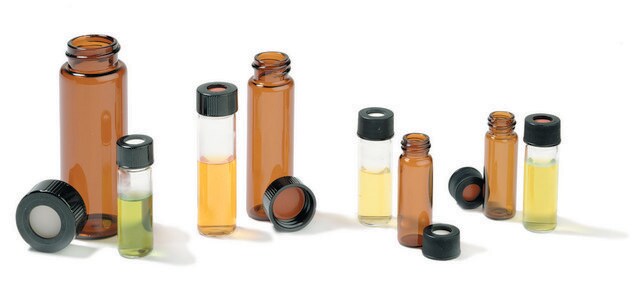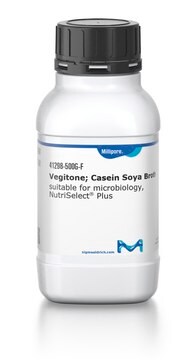Wszystkie zdjęcia(1)
Key Documents
E8656
Heat-Labile Enterotoxin, B subunit (LTB) from E. coli
recombinant, expressed in Pichia pastoris, >90% (SDS-PAGE), lyophilized powder
Synonim(y):
LTB
Zaloguj sięWyświetlanie cen organizacyjnych i kontraktowych
About This Item
Kod UNSPSC:
12352200
NACRES:
NA.77
Polecane produkty
rekombinowane
expressed in Pichia pastoris
Poziom jakości
Próba
>90% (SDS-PAGE)
Postać
lyophilized powder
Warunki transportu
wet ice
temp. przechowywania
2-8°C
Zastosowanie
Heat-Labile Enterotoxin, B subunit (LTB) from E. coli has been used in enzyme-linked immunosorbent assay (ELISA).
Działania biochem./fizjol.
Enterotoxigenic Escherichia coli causes diarrhea through its heat-labile enterotoxin (LT). The LT is a periplasmic protein composed of one A subunit (LTA, 27 kDa) and five non-covalently associated B subunits (LTB, 11.6 kDa each) forming a ring-like pentamer. LTB has high affinity towards the toxin receptor ganglioside GM1, a glycosphingolipid found ubiquitously on the surface of mammalian cells. Ganglioside GM1 facilitates the delivery of the A subunit to the cytosol of the target cell resulting in persistent synthesis of cAMP and subsequently diarrhea. This characteristic makes LTB a good label for microglial cells (due to the enrichment of ganglioside GM1 on their cell surface). In addition, studies made mostly with animal models demonstrated that recombinant LTB could stimulate strong serum and mucosal immune responses against LT. Other studies have indicated that LTB could be used as a potent mucosal adjuvant.
Cechy i korzyści
This compound is a featured product for Cyclic Nucleotide research. Click here to discover more featured Cyclic Nucleotide products. Learn more about bioactive small molecules for other areas of research at sigma.com/discover-bsm.
Postać fizyczna
Lyophilized from a solution containing Heat-Labile Enterotoxin, B subunit in 0.05 M Tris buffer, pH 7.5, 0.2 M NaCl, 3 mM NaN3, and 1 mM sodium EDTA.
Komentarz do analizy
The activity is measured by ELISA using ganglioside GM1-coated plates (Cat. No. G7641). LTB at various concentrations is incubated on the ganglioside GM1 coated wells, followed by anti-cholera toxin antibody (Cat. No. C3062), and peroxidase-labeled goat anti-rabbit IgG (Cat.No. A0545) as the secondary antibody. Binding saturation of 50% may be achieved with = 0.12 μg/mL of LTB.
This page may contain text that has been machine translated.
Hasło ostrzegawcze
Warning
Zwroty wskazujące rodzaj zagrożenia
Zwroty wskazujące środki ostrożności
Klasyfikacja zagrożeń
Acute Tox. 4 Dermal - Aquatic Chronic 3
Kod klasy składowania
11 - Combustible Solids
Klasa zagrożenia wodnego (WGK)
WGK 1
Temperatura zapłonu (°F)
Not applicable
Temperatura zapłonu (°C)
Not applicable
Środki ochrony indywidualnej
Eyeshields, Faceshields, Gloves, type ABEK (EN14387) respirator filter
Certyfikaty analizy (CoA)
Poszukaj Certyfikaty analizy (CoA), wpisując numer partii/serii produktów. Numery serii i partii można znaleźć na etykiecie produktu po słowach „seria” lub „partia”.
Masz już ten produkt?
Dokumenty związane z niedawno zakupionymi produktami zostały zamieszczone w Bibliotece dokumentów.
Klienci oglądali również te produkty
Safety and immunogenicity of escalating dosages of a single oral administration of peru-15 pCTB, a candidate live, attenuated vaccine against enterotoxigenic Escherichia coli and Vibrio cholerae
Chen WH, et al.
Clinical and Vaccine Immunology : CVI, 22(1) (2015)
Preformulation Characterization and Stability Assessments of Secretory IgA Monoclonal Antibodies as Potential Candidates for Passive Immunization by Oral Administration
Hu Y, et al.
Journal of Pharmaceutical Sciences, 109(1) (2020)
Sandra Scheiblhofer et al.
Vaccine, 39(32), 4399-4403 (2021-07-07)
The skin represents an attractive target tissue for vaccination against respiratory viruses such as SARS-CoV-2. Laser-facilitated epicutaneous immunization (EPI) has been established as a novel technology to overcome the skin barrier, which combines efficient delivery via micropores with an inherent
Plastid expression of a double-pentameric vaccine candidate containing human papillomavirus-16 L1 antigen fused with LTB as adjuvant: transplastomic plants show pleiotropic phenotypes
Waheed MT, et al.
Plant Biotechnology Journal, 9(6) (2011)
Nasz zespół naukowców ma doświadczenie we wszystkich obszarach badań, w tym w naukach przyrodniczych, materiałoznawstwie, syntezie chemicznej, chromatografii, analityce i wielu innych dziedzinach.
Skontaktuj się z zespołem ds. pomocy technicznej